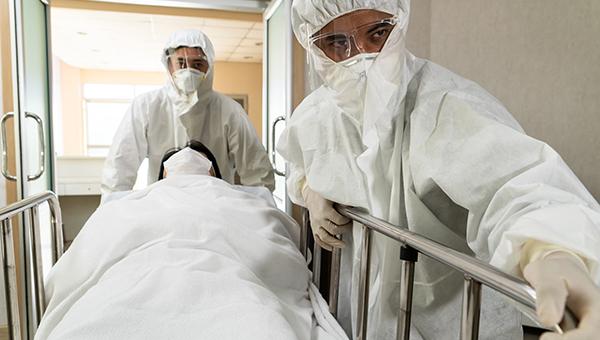STEMI and COVID-19 Often a Lethal Combo, Affirms Largest Study Yet
Everyone needs to help mitigate the risk of spreading SARS-CoV-2 to protect those at risk for STEMI, Herbert Aronow says.

For patients hospitalized with STEMI, having COVID-19 at the same time worsens short-term outcomes, a study of more than 80,000 patients confirms. However, exactly what’s driving the difference still needs to be worked out.
The rate of in-hospital mortality was higher among STEMI patients with COVID-19 versus those treated for STEMI in 2019, regardless of whether the infarction developed out of the hospital (15.2% vs 11.2%; P = 0.007) or once patients were already admitted for another reason (76.6% vs 44.3%; P < 0.001). The differences were similar when the control group was made up of STEMI patients without COVID-19 who were treated in 2020.
Those findings, reported online Friday ahead of print in JAMA, are consistent with the results of previous studies conducted during the pandemic, including the North American COVID-19 ST-Segment Elevation Myocardial Infarction (NACMI) registry, showing poorer outcomes in the setting of SARS-CoV-2 infection.
“It’s not unexpected that patients with COVID-19 in any medical condition would fare worse than those without COVID-19 but who have the same condition,” senior author Herbert Aronow, MD (Brown University and Lifespan Cardiovascular Institute, Providence, RI), told TCTMD.
But the larger, more-representative cohort examined in the current analysis allowed the investigators to better quantify the excess mortality risk, Aronow said, indicating that the impact of COVID-19 on outcomes is sobering: “These are pretty—I would say—shocking numbers when you think about them.”
As always, people who are at risk for STEMI should do everything they can to prevent an infarct by doing things like eating healthier, losing weight, stopping smoking, exercising, and treating their risk factors, Aronow said.
“But for everyone, not just those at risk of STEMI, we need them to do their part to try to mitigate the risk of developing or spreading COVID-19 by wearing masks, social distancing, and receiving a COVID-19 vaccination,” he stressed. “That’s true certainly for those at elevated risk for suffering a STEMI, but it’s just as true for those who may not be at elevated risk of STEMI but who might spread the disease to someone who is.”
These are pretty—I would say—shocking numbers when you think about them. Herbert Aronow
Early on in the pandemic, hospitals started to notice that volumes of STEMIs were dropping, perhaps due to patients fearing exposure to the virus if they sought care. Various studies have pointed to delays in treatment and worse outcomes among patients with STEMI in the context of COVID-19, although it’s not clear if the latter finding is primarily driven by direct effects of the virus or by disruptions in care.
In this study, with lead author Marwan Saad, MD, PhD (Brown University and Lifespan Cardiovascular Institute), the investigators looked at data from the Vizient Clinical Database on 80,449 patients admitted to a PCI-capable center with STEMI in 2019 or 2020; 5% developed the infarction after they were already hospitalized.
Among patients with prehospital STEMI, those with versus without a positive SARS-CoV-2 test were less likely to be white and more likely to be Hispanic and have a heavier comorbidity burden. Patients with COVID-19 also were less likely to undergo coronary angiography, though rates of PCI and CABG did not differ. A similar racial/ethnic pattern was seen among patients with in-hospital STEMI. In this smaller group, COVID-19 was associated with lower rates of coronary angiography, any PCI, and CABG.
The higher rate of in-hospital mortality in patients who had both STEMI and COVID-19 was observed after propensity-score matching and remained consistent in multiple sensitivity analyses.
One noteworthy finding, Aronow said, was that mortality rates were comparable in STEMI patients without COVID-19 in both 2019 and 2020, challenging concerns that interruptions of care pathways associated with the pandemic would worsen outcomes even in patients who hadn’t contracted the virus. “To me that’s very reassuring,” he said. “We all know there were disruptions in care, but I think the important take home is that they weren’t significant enough to impact the mortality of patients who came into the hospital with STEMI who were not infected with COVID-19.”
Mechanisms Behind the Excess Risk
Commenting for TCTMD, Giulio Stefanini, MD, PhD (Humanitas Clinical and Research Hospital IRCCS, Rozzano-Milan, Italy), said the study confirms in a large cohort what has been seen in smaller analyses. “We can state with very robust data that, indeed, myocardial involvement in the setting of COVID has a terrible prognosis,” he said.
But the study cannot address the mechanistic explanation for the excess mortality, which likely involves multiple factors, Stefanini added. Prior studies have shown that viral infections affecting the pulmonary system—like Middle East Respiratory Syndrome (MERS)-related coronavirus, SARS-CoV-1, and influenza—lead to poorer outcomes in patients with MI, he noted. “Certainly there is an underlying inflammatory status that might determine a worse prognosis.”
Moreover, he said, the prothrombotic state associated with COVID-19 could be playing a role, as studies have shown that patients with acute MI and SARS-CoV-2 infection have a higher thrombus burden and a higher degree of microcirculatory obstruction.
And finally, Stefanini said, alterations in usual care protocols leading to delays in reperfusion could have contributed to the increase in mortality.
But whatever the reason, he advised, “patients with COVID infection that have evidence of myocardial involvement should be subject to intensive care [because they] are truly at higher risk of mortality.”
In an accompanying editorial, Alexander Fanaroff, MD (University of Pennsylvania, Philadelphia), and colleagues point to some of the same potential mechanisms, and highlight the importance of making sure patients with symptoms of acute MI obtain immediate medical care even during a pandemic.
“Early reports that demonstrated reduced cardiac catheterization laboratory activations for STEMI and increased cardiac arrests at home raised concerns that many patients with acute MI were not seeking medical care during the pandemic, potentially unraveling three decades of scientific progress,” they write, suggesting that public health messaging could be improved in the future.
“Lockdowns instituted during the first wave of the pandemic may have failed to properly emphasize to the public the differences between hospitals (essential service) and nonessential services, such as bars, restaurants, and gyms. Also, recommendations to ‘self-quarantine’ for 2 weeks when symptoms of COVID-19 were present, some of which may be indistinguishable from symptoms of heart disease, such as dyspnea and cough, may have contributed to many patients delaying or forgoing necessary medical care,” Fanaroff et al say. “As the pandemic continues and in potential future public health emergencies, it is imperative to emphasize the importance of timely care for patients with acute MI.”
Todd Neale is the Associate News Editor for TCTMD and a Senior Medical Journalist. He got his start in journalism at …
Read Full BioSources
Saad M, Kennedy KF, Imran H, et al. Association between COVID-19 diagnosis and in-hospital mortality in patients hospitalized with ST-elevation myocardial infarction. JAMA. 2021;Epub ahead of print.
Fanaroff AC, Garcia S, Giri J. Myocardial infarction during the COVID-19 pandemic. JAMA. 2021;Epub ahead of print.
Disclosures
- Saad and Aronow report no relevant conflicts of interest.
- Fanaroff reports grants from the American Heart Association and the National Institutes of Health and personal fees from Intercept Pharmaceuticals outside the submitted work.





Comments